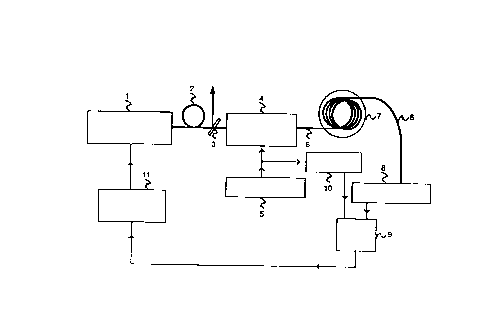Some of the information on this Web page has been provided by external sources. The Government of Canada is not responsible for the accuracy, reliability or currency of the information supplied by external sources. Users wishing to rely upon this information should consult directly with the source of the information. Content provided by external sources is not subject to official languages, privacy and accessibility requirements.
Any discrepancies in the text and image of the Claims and Abstract are due to differing posting times. Text of the Claims and Abstract are posted:
| (12) Patent: | (11) CA 2138105 |
|---|---|
| (54) English Title: | METHOD AND DEVICE FOR STABILIZATION OF THE EMISSION WAVELENGTH OF A LASER |
| (54) French Title: | METHODE ET DISPOSITIF POUR STABILISER LA LONGUEUR D'ONDE D'UN LASER |
| Status: | Expired and beyond the Period of Reversal |
| (51) International Patent Classification (IPC): |
|
|---|---|
| (72) Inventors : |
|
| (73) Owners : |
|
| (71) Applicants : |
|
| (74) Agent: | SMART & BIGGAR LP |
| (74) Associate agent: | |
| (45) Issued: | 1999-03-30 |
| (22) Filed Date: | 1994-12-14 |
| (41) Open to Public Inspection: | 1995-06-17 |
| Examination requested: | 1994-12-14 |
| Availability of licence: | N/A |
| Dedicated to the Public: | N/A |
| (25) Language of filing: | English |
| Patent Cooperation Treaty (PCT): | No |
|---|
| (30) Application Priority Data: | ||||||
|---|---|---|---|---|---|---|
|
The method and the device obtain stabilization by
locking the emission wavelength of the laser to an
absorption line of a gas. The radiation emitted by the
laser is guided through the environment containing the gas
to the detector along an optical waveguide giving rise to
an evanescent field that propagates outside the waveguide
(Figure 1).
L'invention est constituée par une méthode et un dispositif de stabilisation qui asservissent la longueur d'onde d'émission d'un laser à une raie d'absorption d'un gaz. Le rayonnement émis par le laser est guidé jusqu'au détecteur dans l'environnement qui contient le gaz par un guide de lumière qui engendre un champ évanescent se propageant à l'extérieur de ce guide (figure 1).
Note: Claims are shown in the official language in which they were submitted.
Note: Descriptions are shown in the official language in which they were submitted.

2024-08-01:As part of the Next Generation Patents (NGP) transition, the Canadian Patents Database (CPD) now contains a more detailed Event History, which replicates the Event Log of our new back-office solution.
Please note that "Inactive:" events refers to events no longer in use in our new back-office solution.
For a clearer understanding of the status of the application/patent presented on this page, the site Disclaimer , as well as the definitions for Patent , Event History , Maintenance Fee and Payment History should be consulted.
| Description | Date |
|---|---|
| Inactive: IPC expired | 2020-01-01 |
| Time Limit for Reversal Expired | 2008-12-15 |
| Letter Sent | 2007-12-14 |
| Inactive: IPC from MCD | 2006-03-11 |
| Letter Sent | 2001-06-07 |
| Letter Sent | 2000-05-12 |
| Inactive: Multiple transfers | 2000-04-11 |
| Grant by Issuance | 1999-03-30 |
| Pre-grant | 1998-12-17 |
| Inactive: Final fee received | 1998-12-17 |
| Letter Sent | 1998-10-26 |
| Notice of Allowance is Issued | 1998-10-26 |
| Notice of Allowance is Issued | 1998-10-26 |
| Inactive: Approved for allowance (AFA) | 1998-09-17 |
| Amendment Received - Voluntary Amendment | 1998-06-15 |
| Inactive: Status info is complete as of Log entry date | 1998-02-18 |
| Inactive: Application prosecuted on TS as of Log entry date | 1998-02-18 |
| Inactive: S.30(2) Rules - Examiner requisition | 1998-02-13 |
| Application Published (Open to Public Inspection) | 1995-06-17 |
| Request for Examination Requirements Determined Compliant | 1994-12-14 |
| All Requirements for Examination Determined Compliant | 1994-12-14 |
There is no abandonment history.
The last payment was received on 1998-11-16
Note : If the full payment has not been received on or before the date indicated, a further fee may be required which may be one of the following
Patent fees are adjusted on the 1st of January every year. The amounts above are the current amounts if received by December 31 of the current year.
Please refer to the CIPO
Patent Fees
web page to see all current fee amounts.
| Fee Type | Anniversary Year | Due Date | Paid Date |
|---|---|---|---|
| Request for examination - standard | 1994-12-14 | ||
| MF (application, 3rd anniv.) - standard | 03 | 1997-12-15 | 1997-10-16 |
| MF (application, 4th anniv.) - standard | 04 | 1998-12-14 | 1998-11-16 |
| Final fee - standard | 1998-12-17 | ||
| MF (patent, 5th anniv.) - standard | 1999-12-14 | 1999-11-18 | |
| Registration of a document | 2000-04-11 | ||
| MF (patent, 6th anniv.) - standard | 2000-12-14 | 2000-11-20 | |
| Registration of a document | 2001-02-12 | ||
| MF (patent, 7th anniv.) - standard | 2001-12-14 | 2001-11-20 | |
| MF (patent, 8th anniv.) - standard | 2002-12-16 | 2002-11-20 | |
| MF (patent, 9th anniv.) - standard | 2003-12-15 | 2003-11-20 | |
| MF (patent, 10th anniv.) - standard | 2004-12-14 | 2004-11-19 | |
| MF (patent, 11th anniv.) - standard | 2005-12-14 | 2005-11-22 | |
| MF (patent, 12th anniv.) - standard | 2006-12-14 | 2006-11-17 |
Note: Records showing the ownership history in alphabetical order.
| Current Owners on Record |
|---|
| AGILENT TECHNOLOGIES, INC. |
| Past Owners on Record |
|---|
| PIERO GAMBINI |